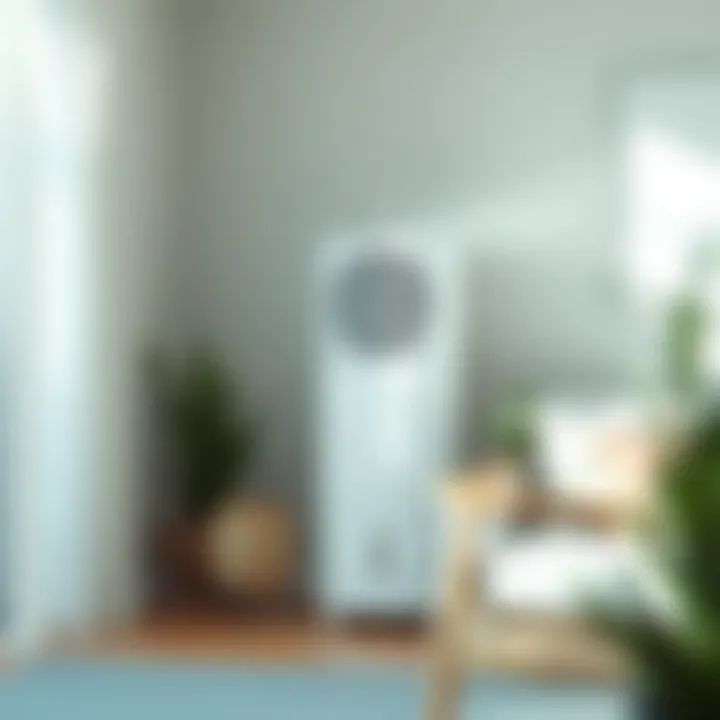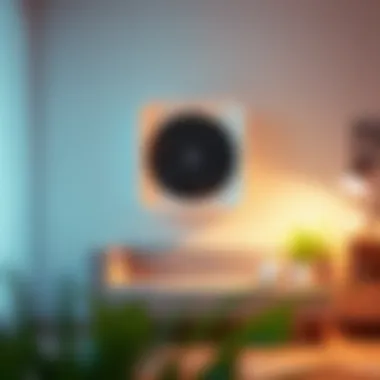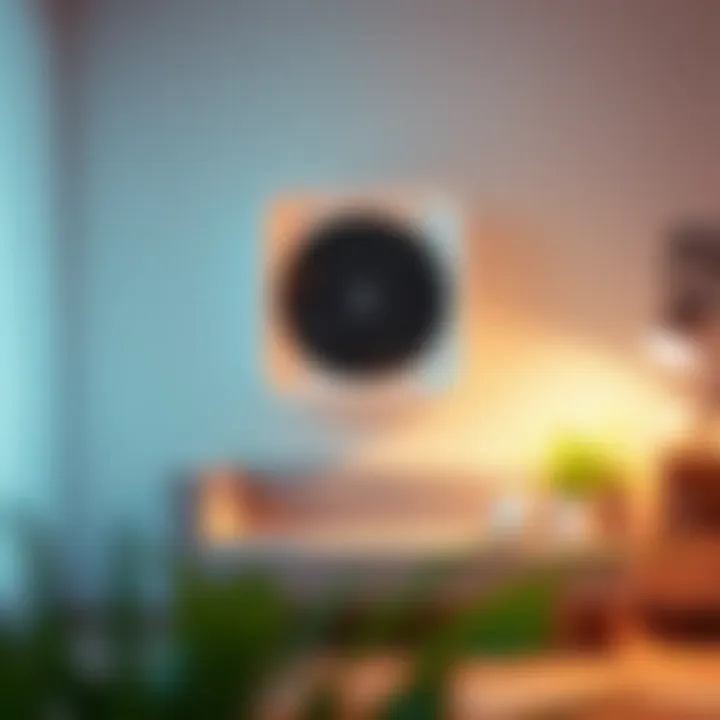The Importance of Investing in Air Purifiers


Intro
In today’s world, where the air we breathe indoors can sometimes be more polluted than the air outside, the discussion surrounding air purification is becoming increasingly relevant. Homeowners, interior design enthusiasts, and health-conscious individuals often seek ways to improve their living environments. Investing in an air purifier isn’t just about keeping the dust bunnies at bay; it's a multifaceted solution that touches on health, aesthetics, and even sustainability.
With various air purifiers available on the market, each boasting unique features and designs, finding the right one for your home can feel overwhelming. Some devices are sleek and modern, fitting seamlessly into a contemporary decor, while others come with a more classic appearance that complements traditional interior designs. Ensure whatever purifier you choose doesn’t clash with your home style but instead enhances it.
In this article, we will explore key aspects that make air purifiers essential in contemporary households. From examining the health benefits to discussing environmental impact and technological advancements in these devices, we aim to break down the layers of relevance that air purifiers hold today.
Consider this: what if one device could help reduce allergens floating in the air, improve your sleep quality, and even reduce asthma symptoms? By digging deeper, we'll shed light on these vital points, allowing you to make an informed decision on whether investing in an air purifier is the right step for your household.
"Breathing clean air is more than just a luxury; it’s a necessity in today’s urban life."
The topics addressed here will not only serve to enlighten but also offer practical, actionable insights. Get ready to take a closer look at how a humble appliance can significantly transform your indoor atmosphere.
Understanding Air Quality
Air quality is a term that encompasses more than just the outdoor conditions of the environment; it includes what we breathe inside our homes. With indoor air monitoring becoming a hot topic, understanding the intricacies of air quality is crucial for maintaining a healthy living space. Homeowners, in particular, must consider the factors influencing the air they breathe daily.
Indoor air quality means ensuring that the air we circulate within our living quarters is free from harmful pollutants that can lead to exacerbated health issues. A significant aspect of this understanding involves comprehending not only how air becomes contaminated but also how those contaminants can affect our well-being.
We often take for granted the air we breathe, but the presence of common pollutants such as dust, smoke, and chemicals can be a silent threat, simmering beneath the surface. Investing in air purifiers emerges as a strategic solution, acting as a barrier between us and those pollutants lurking in the shadows. Homeowners ready to make a change might find that understanding the composition of air in their environment is the first step on this enlightening journey.
The Importance of Indoor Air Quality
Indoor air quality is paramount in today's world where many inhabit sealed environments, often without adequate ventilation. The air within homes can circulate numerous toxins. According to the Environmental Protection Agency, indoor air can be two to five times more polluted than outdoor air. Addressing this issue is not merely a matter of comfort but necessity. Healthy indoor air can lead to reduced respiratory problems, increased sleep quality, and overall enhanced quality of life.
Common Indoor Pollutants
Understanding common indoor pollutants is essential to grasping the necessity for air purifiers. Recognizing what lurks within our walls can shape how we approach indoor living.
Volatile Organic Compounds
Volatile Organic Compounds, or VOCs, are a widespread concern in household air quality. They are found in various products ranging from paints and solvents to even furnishings and personal care items. VOCs easily evaporate at room temperature, which contributes to their prevalence in indoor environments. What positions them as particularly insidious is their odorless nature. Prolonged exposure can lead to headaches, dizziness, and more severe long-term issues. By using air purifiers equipped with carbon filters, homeowners can significantly reduce VOC levels, thus promoting better health and comfort in their homes.
Particulate Matter
Particulate Matter consists of tiny solid or liquid particles suspended in the air, including dust, smoke, and soot. These particles can be so small that they are inhaled deep into the lungs, raising concerns for anyone with respiratory issues or allergies. The World Health Organization has indicated that protracted exposure can lead to significant health ramifications. Utilizing air purifiers with HEPA filters can effectively trap particulate matter, providing families with cleaner air and reducing health risks.
Mold and Mildew
Mold and mildew present formidable challenges in maintaining air quality. These fungi thrive in damp environments and release spores that can cause allergic reactions and respiratory problems. Beyond just being a nuisance, mold can damage the very structure of homes if left untreated. A HEPA air purifier can mitigate moisture in the air, thus preventing mold and mildew from spreading and alleviating symptoms for sensitive individuals.
Bacterial Contaminants
Bacterial contaminants are another common indoor polluter that often goes unnoticed. They can thrive in many household environments, particularly in kitchens and bathrooms. Some bacteria can lead to infections or exacerbate allergies, putting immunocompromised individuals at risk. An air purifier with UV light technology can actively eliminate bacteria, ensuring a healthier atmosphere for all residents.
By educating ourselves on the common indoor pollutants that can compromise air quality, we lay the foundation for healthier living spaces. This understanding reinforces the idea that investing in air purifiers is not just a technological improvement but a means of safeguarding the well-being of our families.
Health Implications of Poor Air Quality
Understanding the health implications of poor air quality is crucial, especially as more people spend significant time indoors. Poorly filtered or contaminated air can affect physical and mental health in numerous ways, often in ways that aren't immediately noticeable until they escalate.
Respiratory Issues and Allergies
Airborne pollutants such as dust, pollen, and smoke can trigger various respiratory issues. For instance, individuals with asthma may find their symptoms exacerbated in homes with poor air quality. This can lead to wheezing, coughing, and shortness of breath. Moreover, allergens like mold spores and pet dander can cause allergic reactions that often go unnoticed until they become severe. According to the American Lung Association, more than 26 million Americans suffer from asthma, a statistic that underscores the necessity of maintaining air quality at home.
Properly functioning air purifiers can significantly reduce these airborne triggers. A high-efficiency particulate air (HEPA) filter, for example, can capture at least 99.97% of particles that are 0.3 microns in diameter. By investing in air purifiers, homeowners can mitigate the potential health risks of allergens and irritants, fostering a more comfortable environment.
Impact on Mental Well-being
There's a growing body of research indicating that indoor air quality affects mental health. When air quality deteriorates, individuals may exhibit increased anxiety levels and reduced overall well-being. Poor air quality can contribute to feelings of lethargy and sadness, akin to the heavy cloud of smoke that hangs over a city on a smoggy day.
Moreover, studies have shown the impact of air quality on cognitive functioning. A Japanese study reveals that people exposed to higher concentrations of indoor air pollutants performed worse on cognitive tests than those in cleaner environments. This highlights the importance of clean air not just for physical health, but also for mental acuity and emotional stability.
Long-term Health Risks
The long-term implications of prolonged exposure to poor indoor air can be quite alarming. Continuous inhalation of pollutants is linked to chronic illnesses such as cardiovascular diseases, respiratory disorders, and even lung cancer. Studies suggest that individuals repeatedly exposed to high levels of particulate matter are significantly more likely to develop heart disease, making air quality a hidden factor in long-term health risks.
Investing in an air purifier serves as a protective measure against these long-term challenges. Having a reliable air purifier helps to reduce the concentration of harmful particles, thereby safeguarding one’s health over the years.


"Investing in an air purifier isn’t just about breathability; it's about investing in a healthier future for yourself and your loved ones."
In sum, the impact of poor air quality on health is multifaceted. The physical effects on respiratory health, the invisible strain on mental well-being, and the long-term risks are critical considerations for any homeowner looking to improve their living environment. Understanding these implications lays the groundwork for appreciating the value of air purifiers as an essential investment.
Functionality of Air Purifiers
Air purifiers are often seen as an essential appliance in homes, especially in today’s world, where indoor air quality is becoming increasingly critical. Understanding how these devices operate offers deeper insight into their importance and utility. Their functionality lies not just in the ability to clean the air but also to enhance the overall comfort of living spaces, addressing specific health concerns and even contributing to environmental sustainability.
How Air Purifiers Work
The operation of air purifiers boils down to a relatively straightforward concept: they draw in air from the environment, filter out harmful particles, and then circulate clean air back into the room. This process typically includes several steps:
- Air Intake: Fans within the unit pull the air toward the device.
- Filtration: Air passes through various filters that trap pollutants such as dust, allergens, and smoke, depending on the technology used.
- Release of Clean Air: Finally, the processed air is released back into the room.
This simple cycle can have a profound impact on indoor environments, particularly in places with high levels of allergens or pollutants.
Types of Air Purification Technologies
Different technologies demarcate how air purifiers clean the air. Here’s a look at three prime types:
HEPA Filtration
HEPA, or High-Efficiency Particulate Air filters, are lauded for their exceptional ability to capture tiny particles, almost as if they had a sixth sense for allergens. These filters can trap at least 99.97% of particles that are 0.3 microns in diameter. This means they can effectively remove pollen, dust mites, and pet dander, making them a highly beneficial choice for those suffering from allergies.
The standout feature of HEPA filtration is its efficiency. It’s so effective that it’s commonly used in hospitals and clean rooms. However, they do have their downsides. HEPA filters need regular replacement and may restrict airflow if they become too dirty, necessitating diligent maintenance.
Activated Carbon
Activated carbon filters grab hold of gases and odors, essentially acting like a sponge. They absorb volatile organic compounds, smoke, and strong smells from cooking or pets, which makes them a popular choice in households with various scents wafting through the air.
A key characteristic of activated carbon is its extensive surface area, which allows these filters to capture a variety of harmful substances. However, over time, they can become saturated and lose their effectiveness, requiring timely replacement to ensure efficacy.
UV Light Technology
This type of technology uses ultraviolet light to eliminate bacteria and viruses present in the air, acting as an antibacterial agent. While it’s not a standalone solution for particulate matter, it works well in conjunction with other filtering methods, making it a beneficial supplement to standard filters.
The unique feature of UV light technology is its ability to neutralize pathogens without adding any chemicals into the environment. Still, it’s worth noting that while UV light can kill microorganisms, it doesn’t necessarily remove larger particles from the air.
With an understanding of these technologies, consumers can make informed choices about which air purifiers best fit their needs. Investing in an air purifier tailored to one’s specific environment and health concerns can transform how people experience their indoor spaces.
Evaluating the Right Air Purifier
When it comes to air purifiers, the choice can sometimes feel overwhelming. With a plethora of models on the market, evaluating the right air purifier is essential to ensure you're getting value that fits your lifestyle and needs. Making an informed decision involves understanding your specific requirements—be it room size, health concerns, or functional preferences. Not only does the right choice impact air quality, but it also shapes your overall well-being and comfort at home.
Determining Your Needs
Room Size and Coverage
The size of the room in which the air purifier will be used greatly affects its effectiveness. Each purifier is designed with a specific coverage area in mind. Essentially, buying an air purifier that’s too small for your space can lead to inadequate purification. Conversely, an oversized model could be a waste of energy and resources. This consideration ties directly into air quality; a purifier that can’t handle your room’s size will struggle to eliminate airborne contaminants, leading to unsatisfactory results.
What should be on your radar is the Clean Air Delivery Rate (CADR) metric. This number indicates how quickly the device can clean the air in a designated area. For instance, if you have a large living room but only invest in a unit suitable for a small bedroom, you’ll likely end up disappointed. Think of it this way: if your purifier is akin to a small broom trying to sweep a giant hall, it simply won’t get the job done.
Specific Health Concerns
People who suffer from allergies, respiratory conditions, or other specific health issues will have unique demands for their air purifier. For example, if you're sensitive to pet dander or mold, you'll need a model equipped with a HEPA filter, which captures particles as small as 0.3 microns. That’s vital since these allergens can easily circulate throughout your home and provoke serious health reactions.
Additionally, certain purifiers may target particular contaminants better than others. If you live in an area with high levels of ozone, an activated carbon filter could be your best bet. The unique feature here is that different purifiers offer tailored solutions for various pollutants. In doing so, they provide an effective line of defense, especially for those whose health is at stake.
Key Features to Consider
Noise Levels
The operational noise of an air purifier can often slip under the radar during the selection process. Yet, this is important, especially if you'll use it in bedrooms, nurseries, or quiet workspaces. Most people prefer a unit that operates quietly; after all, there’s little appeal in an air purifier sounding like a jet engine, right? Noise levels are generally measured in decibels (dB), where a lower number indicates quieter performance.
Some models have a “sleep mode,” which makes them operate at lower speeds to minimize noise while still filtering the air effectively. Evaluating noise levels can lead you to not just comfort in living spaces but also improved quality of life, as peace of mind often translates to better rest and concentration.
Filter Replacement Costs
Behind the scenes, operating an air purifier isn’t just about the upfront cost. Consider the expenses associated with filter replacements, as these can add up over time. Some purifiers use filters that need changing more frequently than others, leading to increased costs. On average, a HEPA filter needs replacement every 6 to 12 months depending on usage and the environment. This recurrent expense can catch buyers by surprise if overlooked.
It’s wise to research the price and availability of replacement filters for models you’re interested in. Remember, if replacing the filter feels like emptying your wallet every few months, the initial bargain of the unit might not seem like such a steal after all.


Smart Features
In today’s fast-paced world, the ability to control an air purifier remotely has transitioned from luxury to necessity for many users. Smart features allow one to monitor air quality levels through mobile apps or smart home systems. This means you could adjust settings from anywhere—whether you’re lounging on the sofa or out running errands.
A unique aspect is the integration of air quality sensors that adjust the purifier's performance based on the detected levels of pollutants automatically. While these features add convenience, they also elevate the initial price point. Weighing their advantages—such as potential energy savings and ease of use—against added costs can help clarify if they suit your needs.
The right air purifier doesn’t just clean your air; it also enhances your overall comfort, health, and happiness within your home environment.
Thus, when evaluating the right air purifier, it’s crucial to consider not just the immediate cost but the long-term investment in your health and well-being.
Air Purifiers and Allergies
Air quality has a direct link to human health, particularly for individuals suffering from allergies. In the context of this article, exploring the connection between air purifiers and allergies is vital. These devices emerge as essential tools, providing relief in environments teeming with airborne irritants. Their efficiency in trapping allergens like dust, pollen, and pet dander significantly transforms indoor spaces into more hospitable havens.
Alleviating Seasonal Allergies
Seasonal allergies can turn a sunny day into a sneezing fit for many. As certain pollens float through the air during spring and summer, those sensitive to them often find their symptoms worsened indoors as well. Here's where air purifiers can play a critical role. By utilizing HEPA filtration systems, these devices capture up to 99.97% of particles as small as 0.3 microns, effectively lowering the pollen count inside your home.
Moreover, operating an air purifier allows for a breath of fresh air, even when outside conditions seem bleak. Many individuals have reported a marked improvement in their allergy symptoms soon after incorporating air purifiers into their home setup. This suggests that rather than avoiding the outdoors altogether, investing in a quality air purifier lets you enjoy nature while minimizing its negative impacts. Some even go so far as to say an air purifier can be a game-changer during peak allergy seasons.
Dust Mite and Pet Dander Reduction
Dust mites and pet dander are common culprits in indoor allergies, creating discomfort that many homeowners experience. Dust mites thrive in warm, humid environments, often settling in soft furnishings like carpets, bedding, and upholstered furniture. Luckily, air purifiers equipped with advanced filtration systems can combat this issue effectively.
Using an air purifier on a consistent basis helps capture these microscopic intruders before they recycle back into the air. A study from the Environmental Protection Agency noted that regular use of HEPA filters significantly reduces the concentration of indoor allergens, contributing to a healthier living space. For households with furry friends, pet dander poses another layer of challenge. Investing in air purifiers can significantly mitigate these allergens, creating an environment that’s more pleasant for all occupants.
"The right air purifier offers not only protection against allergens but also peace of mind for those living with allergies."
While these devices are not a complete solution—good housekeeping habits remain essential, such as regular vacuuming and washing linens—they provide a significant edge. When paired with proper maintenance and cleaning routines, air purifiers shine as reliable allies in fighting indoor allergens, tempering the effects they can have on daily life. It’s clear: when it comes to alleviating distress caused by allergens, investment in an air purifier is a step toward creating a more welcoming indoor environment.
Environmental Considerations
In this age of climate consciousness, considering the environmental aspects of our household appliances is crucial. Air purifiers, often seen solely as health devices, also play a significant role in promoting sustainability. By selecting energy-efficient models and sustainable filter options, homeowners can breathe cleaner air while minimizing their ecological footprint.
Energy Efficiency of Air Purifiers
When it comes to air purifiers, energy efficiency should be at the forefront of your mind. An efficient device doesn’t just save you money on your electric bill, it also lessens the strain on our planet’s resources. Most air purifiers have energy ratings, which are categorized by icons, from the worst to the best. Models with the Energy Star label stand out as leaders in minimizing energy consumption while effectively cleaning indoor air.
It’s worth noting that some air purifiers can actually consume more power than others, particularly if they are running all day. Thus, purchasing a model that utilizes smart technologies can be beneficial.
- Smart Sensors: Automatically adjust the power intake based on the air quality.
- Eco Modes: Allow the device to operate at lower settings when contaminants are minimal.
By opting for a model that is energy-efficient and has smart features, you not only help reduce your carbon footprint but also ensure that your air purifier works in harmony with your living space. Without proper education on energy considerations, people may buy high-powered machines thinking they are cleaner, but end up wasting resources instead.
Sustainable Filter Options
The type of filters your air purifier uses is also a pivotal consideration. Traditional HEPA filters do an excellent job at capturing dust and allergens but often require replacement every few months, thus contributing to waste. Recently, several companies have recognized this issue and have developed filters made from sustainable materials. Some innovative brands offer biodegradable filters, which break down naturally over time, mitigating landfill impact.
Here are a few sustainable options:
- Washable Filters: These can be reused multiple times, saving resources in manufacturing new filters.
- Natural Fiber Filters: Made from materials like cotton or paper, they provide filtration without the long-term waste problem.
- Recyclable Filters: Other filters can be returned to manufacturers for recycling, creating a loop that keeps materials in use longer.
By investing in air purifiers that incorporate sustainable filter options, you not only reduce your reliance on single-use plastics but also contribute to a circular economy. It's all about making informed choices; every small step adds up to significant environmental benefits.
"Every decision we make has a ripple effect on our environment. Simple adjustments in our choices can indeed shape a greener future."
User Experiences and Testimonials
Real-Life Impact of Air Purifiers
When it comes to air purifiers, the value often lies not just in technical specifications or efficiency ratings, but in the lived experiences of those who use them. Hearing from regular folks about their personal journeys with air purifiers can be eye-opening. These user experiences serve as testament to the tangible benefits these devices can offer, going beyond mere marketing claims.
Many homeowners report a marked difference in their indoor environment after introducing an air purifier into their space. For instance, families with pets often face a battle with dander and odors. One user shared that after acquiring a HEPA air purifier, their living room transformed from a sneeze-inducing zone into a breath of fresh air. The device not only helped capture pet hair and dander but also contributed to a more welcoming atmosphere for guests.
Another user, dealing with seasonal allergies, found relief that was hard to come by. They described their experience of waking up in the morning, no longer reaching for tissues right away. The air purifier significantly reduced irritating particles, making the entire home feel fresher and cleaner. As they noted, "It’s like having a personal filtration system that works around the clock, giving me peace of mind."
"I used to dread cleaning my home during allergy season. Now, I just turn on my air purifier and breathe easy. It's been a game changer for me!"
Moreover, there's a growing community of individuals who vocalize their experiences on platforms like Reddit and Facebook. These testimonials foster a sense of connection among users. They share tips on maintaining air purifiers, discuss the longevity of filters, and even swap stories about encountering unique pollutants or issues in their specific environments. Such exchanges can guide prospective buyers on what to expect and how to effectively utilize these devices in their own homes.
In terms of health benefits, many have reported a notable decrease in respiratory issues after integrating air purifiers into their lifestyle. A person living in a bustling city filled with vehicle emissions shared that since purchasing an air purifier, they have dealt with fewer headaches and respiratory discomforts. This correlation underscores how air purifiers can alleviate not just discomforts but also contribute to overall health and well-being.


As inquiries regarding air quality increase, users are taking initiative to share their findings. It's worth mentioning that some testimonials also provide cautionary tales. For instance, there are users who initially purchased air purifiers expecting them to be a one-stop solution for air quality issues—only to realize that they needed to combine it with better ventilation and regular cleaning practices. This highlights the importance of understanding that while air purifiers are effective, they are part of a larger strategy in maintaining a healthy living environment.
In summary, user experiences are a crucial backbone of understanding the real-world applications and effectiveness of air purifiers. They paint a picture that specifications alone can't capture. The personal accounts remind potential buyers of the tangible improvements in air quality, health, and overall home comfort that investing in an air purifier can bring.
Addressing Misconceptions
Understanding air purifiers can feel like navigating a dense forest without a map. Many homeowners find themselves tangled in myths and misunderstandings regarding these appliances, which can prevent them from making informed decisions. Addressing these misconceptions is crucial because it allows individuals to make educated choices that affect their health and the overall quality of life.
When exploring air purifiers, it is essential to distinguish fact from fiction. While these devices boast a plethora of benefits, misconceptions can cloud judgement and foster skepticism. By illuminating the truths behind air purifiers, potential users can better appreciate their value in creating a healthier home environment. Let's break down some common myths that persist and clarify what air purifiers can genuinely achieve.
Common Myths About Air Purifiers
A myriad of myths surrounding air purifiers often leads to confusion. Let’s look at a few prominent ones:
- They eliminate all pollutants. While air purifiers are effective, they do not capture every single pollutant. Larger particles like dust and pet dander readily get caught, but some gases and fumes may escape if they are not designed to handle them specifically.
- Air purifiers are only necessary for allergy sufferers. Many believe that air purifiers are exclusively beneficial for those with allergies. However, they offer value for everyone by reducing pollutants that can impact health over time, including smoke, dust, and animal hair.
- Exposure to ozone is harmless. Some air purifiers emit ozone as a byproduct, which is often marketed as a benefit. In truth, ozone can exacerbate respiratory issues and does more harm than good in most cases. Look for units that specifically state they are ozone-free.
Confronting these and other misconceptions helps clarify the practical applications of air purifiers. Recognizing their capabilities and limitations allows for informed comparisons with other air-cleaning strategies, such as proper ventilation and humidity control.
Understanding Expectations vs. Reality
Many people enter the air purifier market with expectations that might be a tad too optimistic, leading to disappointments when they don't deliver. It’s imperative to have a balanced view.
For instance, some folks hope that just placing an air purifier in a corner of a room will miraculously transform the air quality of their entire home. The reality is that for maximum effectiveness, placement matters. For an air purifier to function effectively, it should be located where it can draw in air freely, often requiring it to be at least a few feet away from walls or furniture.
Also, it’s essential to grasp that air purifiers are not magical solutions. They work best as part of a broader approach to indoor health, including regular cleaning habits and ventilation. Some users may anticipate an immediate improvement in symptoms like sneezing or congestion. However, it can take time for air quality to improve noticeably, especially if allergens are consistently present in the environment.
"The reality of using air purifiers is that they are part of a bigger picture. Don't expect them to be the sole solution to your indoor air issues."
Being realistic with expectations saves one from the dreaded buyer’s remorse. Just like investing in a reliable vehicle doesn't guarantee the absence of traffic, equipping your home with an air purifier doesn't mean all air quality problems vanish overnight. Proper maintenance and usage are keys to unlocking their full potential, and understanding this can lead to a more satisfying experience.
Cost-Benefit Analysis
When considering air purifiers, it's crucial to weigh the costs against the benefits. This analysis is not just about numbers; it’s an exploration of how investing in quality air purification can enhance your daily life. Homeowners and those who often host gatherings have a vested interest in ensuring that their spaces are not only aesthetically pleasing but also healthy. Therefore, understanding the cost-benefit landscape becomes essential for making an informed decision.
Upfront Costs vs. Long-Term Savings
The upfront cost of an air purifier can vary widely, influenced by the brand, technology, and features involved. Basic models may start at around $50, while high-end purifiers equipped with the latest technologies could reach upwards of $1,000. Evaluating these upfront costs is the first step, but it is just the tip of the iceberg.
In contrast to the initial purchase price, the long-term savings can be quite substantial. It’s like peeking behind the curtain; what may seem like a hefty price tag could lead to significant reductions in expenses over time. Here are some aspects to consider:
- Energy Efficiency: Modern air purifiers are designed to be energy-efficient, which means they won't send your electricity bill through the roof. Running an energy-efficient air purifier could cost as little as a few dollars a month.
- Health Savings: Reducing health issues linked to poor air quality can lead to fewer doctor visits and medications. Think of it as insurance; investing now could save you more later.
- Home Value: Maintaining good indoor air quality can potentially increase your home’s value, especially in real estate markets that prioritize eco-friendly features.
In sum, while the initial investment may feel daunting, the long-term financial benefits can far outweigh those costs, making air purifiers a wise investment for the health-conscious homeowner.
Health Cost Savings
Investing in an air purifier isn’t just an outlay; it's a strategic move for your health. Poor indoor air quality can lead to a slew of respiratory issues, allergies, and even long-term diseases. The health ramifications can be costly, both in terms of healthcare expenses and the quality of life.
By improving the air quality in your home, you open the door to substantial health cost savings. Here’s how:
- Reduced Allergies: For those with allergies, having cleaner air can mean fewer reactions. Fewer allergy symptoms equate to less money spent on prescription medications or over-the-counter remedies.
- Decreased Respiratory Issues: Clean air can mitigate the risk of asthma and other respiratory illnesses, reducing hospital visits and associated costs.
- Enhanced Overall Health: Healthier air contributes to better sleep, increased productivity, and an overall boost in well-being, indirectly saving costs related to mental health treatments and lifestyle diseases.
Ultimately, while one might stumble upon the upfront expenses associated with purchasing an air purifier, the long-term health benefits render these devices essential investments.
"An air purifier is not just a device; it’s peace of mind and a proactive step towards health."
Ending: The Value of Air Purifiers
The exploration of air purifiers in this article leads us to a significant conclusion: investing in these devices is not merely a trend; it’s a necessity for improving indoor air quality, health, and overall well-being. This final section serves to tie together all the insights and information we've discussed, emphasizing the multifaceted value that air purifiers bring into our daily lives.
Indoor air quality has a profound impact on our health both physically and mentally. Poor air quality can lead to various health issues, from respiratory problems to anxiety. In light of this, air purifiers emerge as a practical solution. They work diligently to remove common indoor pollutants, allergens, and harmful particulate matter.
From HEPA filtration that captures the tiniest of particles, to activated carbon which absorbs odors and volatile organic compounds, the varieties of air purification technologies offer tailored solutions for different needs. An air purifier can be particularly beneficial for individuals suffering from allergies or those with existing health conditions that may be exacerbated by poor air quality.
Key Benefits of Air Purifiers
- Health Improvement: By filtering out pollutants, air purifiers directly contribute to reducing health risks. This can lead to fewer doctor visits and lower medical costs over time.
- Enhanced Comfort: Breathing clean air creates a more pleasant living environment. Air purifiers help tackle persistent issues such as pet dander and dust mites, which can significantly affect comfort levels in a home.
"Investing in air purifiers is an investment in well-being. Clean air sets the foundation for a healthier lifestyle."
Considerations When Investing
Before making a purchase, it’s crucial to evaluate what features matter most based on individual circumstances. Factors such as room size, specific health concerns, and noise levels all play a pivotal role in determining the best air purifier for your needs. Additionally, consider long-term costs such as filter replacements and energy consumption.
Final Thoughts
To wrap it up, the value of air purifiers extends beyond mere technology. They signify a commitment to health and well-being in an increasingly polluted world. For homeowners, gardening enthusiasts, or anyone hosting indoor gatherings, the decision to invest in an air purifier now seems more like a common-sense choice rather than just a luxury. Each breath taken in a space fitted with an air purifier is a testament to foresight and care—in essence, they are a keystone of modern indoor living.







